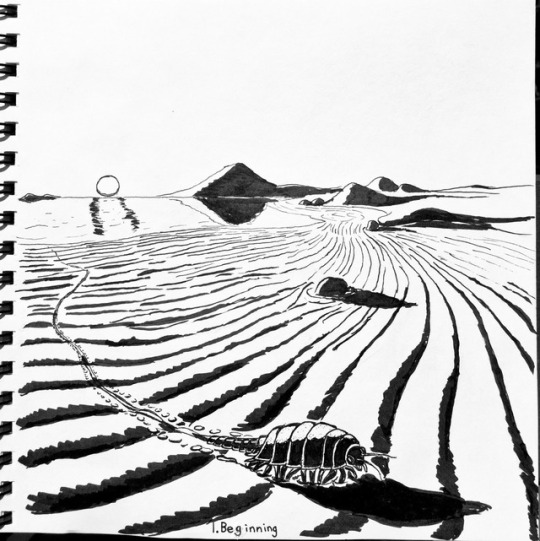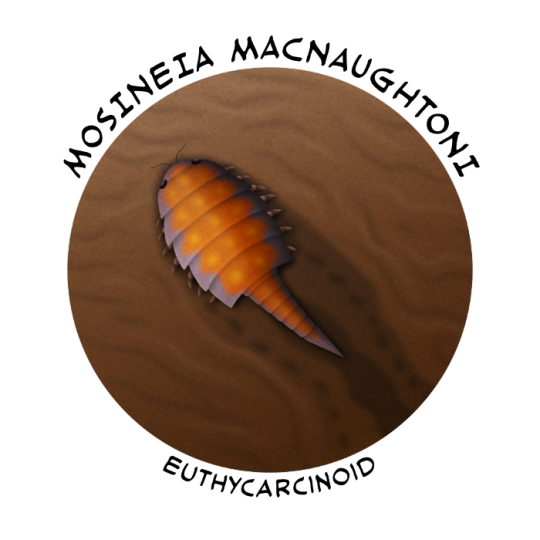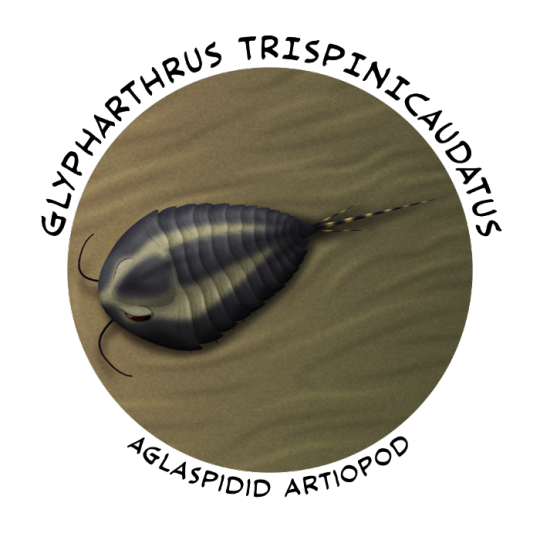#protichnites
Photo

October 1st, “Beginning”
First day of Inktober! In keeping with the theme of beginnings, I decided to go back--way back--to the Late Cambrian period. On a tidal flat somewhere in what will one day be North America, a euthycarcinoid--an ancient arthropod that may represent the common ancestor of crustaceans, myriapods, and hexapods--crawls along the exposed mud in search of bacterial films to graze on. In its wake it leaves behind a distinctive track, fossils of which will one day bear the name Protichnites. This creature’s brief forays out of the water mark the beginning of life on land. Everything that came after--plants, insects, mollusks, tetrapods--followed in its footsteps.
12 notes
·
View notes
Photo

Cambrian Explosion #56: Euthycarcinoidea
The euthycarcinoids were a group of euarthropods known from the mid-Cambrian to the mid-Triassic (~500-254 million years ago), surviving through multiple mass extinctions including the devastating "Great Dying" at the end of the Permian that finished off the trilobites. But despite an evolutionary history spanning around 250 million years they have a very sparse fossil record, extremely rare and known from less than 20 species across their entire time range.
For a long time their affinities were uncertain, and they've been variously suggested to have been crustaceans, trilobites, or chelicerates, or even to have been a lineage of earlier stem-euarthropods. But since the early 2010s better understanding of their anatomy has placed them in the mandibulates, probably as the closest relatives of the myriapods and helping to close the gap between the aquatic ancestors of that group and their earliest known terrestrial forms.
Most known euthycarcinoid species lived in brackish and freshwater environments, but some Cambrian species have been found in tidal flats associated with the terrestrial trace fossils Protichnites and Diplichnites – indicating that they were amphibious and some of the very first animals able to walk on land.
Mosineia macnaughtoni is a Cambrian euthycarcinoid known from the Blackberry Hill fossil deposits in Wisconsin, USA (~500-489 million years ago).
At around 10cm long (4") it was fairly large for a Cambrian euarthropod, and like other euthycarcinoids it had a three-part body plan with a head bearing antennae, eyes, and mandibles, a thorax with pairs of uniramous legs, and a limbless abdomen that ended in a tail spine.
It probably ventured out of the water to feed on the rich microbial mats that covered the mudflats, taking advantage of an environment free from predators and competition. It may also have laid and fertilized its eggs on the shore, similarly to modern horseshoe crabs.
———
Nix Illustration | Tumblr | Twitter | Patreon
#science illustration#paleontology#paleoart#palaeoblr#cambrian explosion#cambrian explosion 2021#rise of the arthropods#mosineia#euthycarcinoidea#mandibulata#euarthropoda#arthropod#panarthropoda#ecdysozoa#protostome#bilateria#eumetazoa#animalia#art#just mosi-ing along
143 notes
·
View notes
Photo


Cambrian Explosion #51: Artiopoda – Surprising Lookalikes
The aglaspidid artiopodans were a major lineage of early Paleozoic euarthropods – one of the most diverse after their cousins the trilobites, although far far behind them in terms of actual species numbers.
But despite their diversity and worldwide range actual fossils of them are incredibly rare, and for a long time they were considered to be a "problematic" wastebasket group of uncertain affinities, mainly interpreted as being related to the chelicerates. More recently evidence from preserved limb anatomy has instead placed them within the artiopodans in a grouping known as vicissicaudatans, closely related to forms like Sidneyia and the later cheloniellids.
Unusually for euarthropods they had a phosphatic exoskeleton, and they experienced their main burst of diversification in the late parts of the Cambrian period, after most of the actual evolutionary explosion had already settled.
They mainly inhabited shallow near-shore environments, and may actually have been some of the very first animals to venture onto land. Some examples of the trace fossil Protichnites might represent aglaspidids scuttling over the Cambrian shorelines to mate and lay their eggs in a similar manner to horseshoe crabs.
———
Kodymirus vagans was first discovered in the 1960s but was an enigmatic species for quite a while. It was interpreted as the earliest known sea scorpion in the mid-1990s, but more recently it's been reclassified as a vicissicaudatan artiopodan that wasn't quite a true aglaspidid, instead being a very closely related "stem" lineage.
Known from the Paseky Shale in Czechia (~514-509 million years ago), it reached about 8cm long (~3") and had a distinctive pair of large spiny appendages that resembled the "great appendages" of stem-euarthropods like megacheirans. However, unlike the disputed anatomical origins of those structures, Kodymirus' huge claws were instead modified from its first pair of legs in a striking case of convergent evolution.
(Some older reconstructions depict it with six pairs of enlarged limbs, but this is based on the outdated sea scorpion interpretation. A more recent study of specimens found individuals were only ever preserved with one pair each.)
It lived in very shallow brackish coastal waters in a calm lagoon, in what seems to have been a rather sparse ecosystem completely lacking many common Cambrian animals like trilobites and brachiopods. Possibly the environment was isolated and inhospitable enough that it allowed Kodymirus to take advantage of an ecological role usually occupied by other arthropods.
Scratch-mark trace fossils in the Paseky Shale match the size and shape of Kodymirus' raptorial appendages, but only ever show one side being used at a time. This suggests it was an active predator that swam along just above the seafloor, trailing the spines of one appendage through the soft surface of the sediment and "skimming" for hidden prey to grab.
———
Glypharthrus trispinicaudatus was part of a lineage of Cambrian aglaspidids that were even more trilobite-shaped than most other artiopodans, convergently evolving a very similar appearance despite not being particularly closely related to them.
Known from the Guole biota in southern China (~490 million years ago), it was about 3cm long (1.2"). It had a large semicircular head shield with elongated eyes, 12 body segments, and a pair of furcae and a long tail spine at the rear of its body.
Like most aglaspidids it inhabited fairly shallow waters, with the Guole fossil assemblage probably representing an upper continental slope.
———
The aglaspidids were successful and hardy enough to survive past the end of the Cambrian and into the Ordovician – although "Ordovician-type" members of the group had a distinct appearance compared to their earlier relatives, with more rounded head shields and their eyes either very reduced or missing entirely, suggesting that they took up a different lifestyle.
They eventually disappeared towards the end of the Ordovician, about 450 million years ago, possibly struggling to cope with increasing competition from the ongoing Great Ordovician Biodiversification Event.
———
Nix Illustration | Tumblr | Twitter | Patreon
#science illustration#paleontology#paleoart#palaeoblr#cambrian explosion#cambrian explosion 2021#rise of the arthropods#kodymirus#glyptharthrus#aglaspidida#artiopoda#euarthropoda#arthropod#panarthropoda#ecdysozoa#protostome#bilateria#eumetazoa#animalia#art#convergent evolution#the cambrian really liked evolving a nice pair of grabby hands huh
106 notes
·
View notes